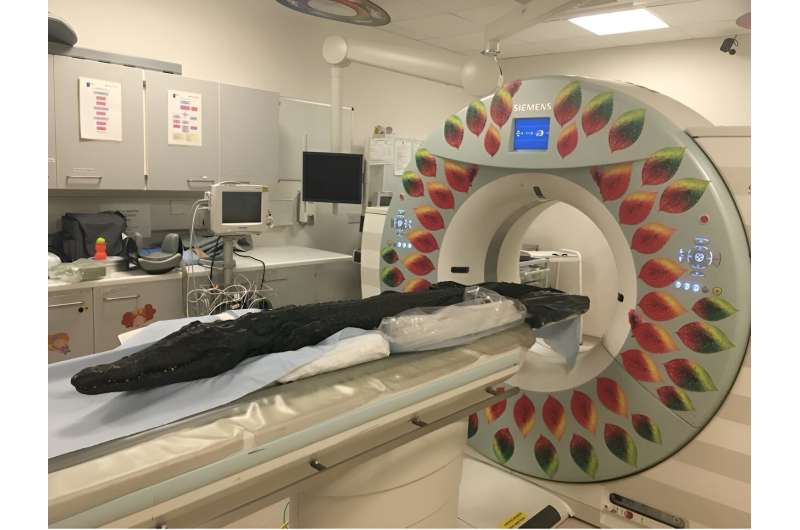
The ancient crocodile was mummified, perhaps as an offering to Sobek. Credit: Lidija McKnight, Credited Author
What do you think of when you think of ancient Egyptian mummies? Perhaps your mind takes you back to a school trip to the museum when you were confronted with a mummified person inside a glass case. Or perhaps think of mummies as portrayed by Hollywood, mummies emerging from their sandy graves with soiled bandages blowing in the wind.
It may surprise you to know that the Egyptians also preserved millions of animals.
In a recent study, my colleagues and I discovered remarkable details about the last hours of life of a crocodile that was mummified by ancient Egyptian embalmers. Using a CT scanner, we were able to determine how the animal died and how the body was treated after death.
For the Egyptians, animals performed an important religious function, moving between the earthly and divine realms. Falcons were associated with the sun god, Horus, because they flew high in the sky, closest to the sun (and therefore to the god himself). Cats were associated with the goddess Bastet, a brave and fierce mother figure.
Most animal mummies were created as votive offerings or gifts.
Animal mummies provide a glimpse of the natural world, taken roughly between 750 BC and 250 AD. Some of these mummified species are no longer found in Egypt.
For example, the ancient Egyptians would have seen sacred ibises, long-legged birds with curved beaks, along the banks of the Nile every day. Birds were mummified in their millions as offerings to Thoth, the god of wisdom and writing. The birds are no longer in Egypt as climate change and the effects of desertification have caused them to move south to Ethiopia.
Another commonly mummified animal was the crocodile. Although crocodiles lived in the Nile during ancient times, the completion of the Aswan Dam in 1970 prevented them from moving north to the delta in lower Egypt.
Crocodiles were associated with Sobek, God of the Nile and the god whose presence signaled the annual flooding of the Nile, which provided water and nutrient-rich mud to their farmland.
Crocodiles were mummified in large numbers as offerings to Sobek. They were used as talismans throughout Pharaonic Egypt to ward off evil, either by wearing crocodile skin as clothing, or by hanging a crocodile over the doors of houses.
Most crocodile mummies are of small animals, suggesting that the Egyptians had the means to hatch and keep the young alive until they were wanted. Archaeological evidence reinforces this theory, with the discovery of areas dedicated to incubating eggs and raising young. Some were pampered as cult animals and allowed to die a natural death.
As the crocodiles grew larger, the danger to the crocodile keepers increased, perhaps suggesting that larger specimens were caught in the wild and rushed for mummification. Research on the mummified remains of larger animals has revealed evidence of trauma to the skull possibly inflicted by humans as an attempt to immobilize and kill the animal.
What we found
The crocodile mummy in our study has evidence to suggest how these animals might have been captured. The mummy is held in the collection of the Birmingham Museum and Art Gallery, United Kingdom, and is 2.23 meters long. In May 2016, the large crocodile mummy, which was part of a wider study by a team of researchers I work with from the University of Manchester, was transported to the Royal Manchester Children’s Hospital to undergo a series of studies radiographic.
Medical imaging techniques allow researchers to study ancient objects without destroying them, as studies of mummies once did.
X-rays and CT scans showed that the animal’s digestive tract was filled with small stones known as “gastroliths”. Crocodiles often swallow small stones to help them digest food and regulate movement. Gastroliths suggest that embalmers did not perform evisceration, the process of removing internal organs to delay decay.
Among the stones, footage also showed the presence of a metal hook and a fish.
The study suggests that the large, mummified crocodiles were caught in the wild using hooks baited with fish. It adds weight to the account of the Greek historian Herodotus, who visited Egypt in the 5th century BC and wrote of pigs being beaten on the banks of the river to lure crocodiles, which were caught on baited hooks set in the Nile. .
Unlike many aspects of life in ancient Egypt, little information was recorded about animal worship and mummification. The classical writers who traveled the country remain some of our best sources of information.
Colleagues from the Birmingham School of Jewelery helped replicate the hook in bronze, the metal most likely used to create the ancient original, to go on display alongside the crocodile mummy.
Modern technology is helping us learn more and more about our ancient past. I can only imagine what secrets technology can help uncover in the future.
Provided by The Conversation
This article is republished from The Conversation under a Creative Commons license. Read the original article.![]()
citation: How a 3,000-year-old Egyptian crocodile’s last meal was brought back to life using modern science (2024, August 3) retrieved August 4, 2024 from https://phys.org/news/2024-08-meal-year – egyptian-crocodile-brought.html
This document is subject to copyright. Except for any fair agreement for study or private research purposes, no part may be reproduced without written permission. The content is provided for informational purposes only.